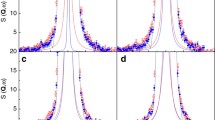Abstract
Results of simple computer simulations and model calculations for ion conducting rotor phases are compared to quasi-elastic neutron scattering data from solid solutions of sodium orthophosphate and sodium sulphate, xNa2SO4·(1 − x)Na3PO4. These materials are not only sodium fast-ion conductors in their high-temperature cubic phases but also show considerable dynamic reorientation disorder of their tetrahedral anions. At an elastic energy resolution of about 100 _eV, neutron spectrometry monitored oxygen scattering due to anion reorientation which occurs on the picosecond time scale. This thermally activated process exhibits activation energies between 0.184 eV (x _ 0.0) and 0.052 eV (x _ 0.5). Analysis of the quasielastic intensities as a function of scattering vector Q gives clear evidence of the involvement of cations in the anion reorientation. Increasing the elastic resolution to about 1 _eV full width at half-measure (FWHM) (thereby shifting the dynamic window to the nanosecond scale) allowed examination of sodium diffusion in xNa2SO4·(1 − x)Na3PO4. This process consists predominantly of thermally activated jumps between tetrahedrally coordinated sites, the activation energies ranging from 0.64 eV for x = 0.0 to 0.30 eV for x = 0.5.
Similar content being viewed by others
References
A. Lundén: Enhancement of cation mobility in some sulphate phases due to a paddle-wheel mechanism. Solid State Ionics 28–30, 163 (1988).
A. Lundén: Evidence for and against the paddle-wheel mechanism of ion transport in superionic sulphate phases. Solid State Commun. 65, 1237 (1988).
A. Lundén and M.A.K.L. Dissanayake: On the ionic conductivity and phase transitions in the Li2SO4-Li2WO4 system and their relation to ion transport mechanism. J. Solid State Chem. 90, 179 (1991).
A. Lundén: Cation transport mechanisms in high-temperature rotor phases of sulfates. J. Solid State Chem. 107, 296 (1993).
A. Lundén: Paddle-wheel versus percolation model, revisited. Solid State Ionics 68, 77 (1994).
E.A. Secco: Fast cation conductivity by percolation in alkali sulfate compositions. Solid State Ionics 28–30, 168 (1988).
E.A. Secco: Ion transport in sulfates: percolation mechanism versus paddle-wheel mechanism. Solid State Commun. 66, 921 (1988).
E.A. Secco: Comments on electrical conductivity and phase diagram of the system Li2SO4–Li3PO4. Solid State Ionics 45, 335 (1991).
E.A. Secco: Paddle wheel mechanism in lithium sulfates: Arguments in defense and evidence against. J. Solid State Chem. 96, 366 (1992).
E.A. Secco: Paddle-wheel versus percolation model. Solid State Ionics 60, 233 (1993).
M. Jansen: Volume effect or paddle-wheel mechanism—Fast alkalimetal ionic conduction in solids with rotationally disordered complex anions. Angew. Chem. Int. Ed. Engl. 30, 1547 (1991).
M. Ferrario, M.L. Klein, and I.R. McDonald: Cation transport in lithium sulphate based crystals. Mol. Phys. 86, 923 (1995).
D.M. Wiench and M. Jansen: About Na3PO4: Experiments on the synthesis of pure samples, crystal structure of the hightemperature modification. Z. Anorg. Allg. Chem. 461, 101 (1980).
D.M. Wiench and M. Jansen: Substitution of Na2SO4 into the high-temperature modification of Na3PO4. Z. Anorg. Allg. Chem. 486, 57 (1982).
J.T.S. Irvine and A.R. West: Sodium ion-conducting solid electrolytes in the system Na3PO4–Na2SO4. J. Solid State Chem. 69, 126 (1987).
R. Harrison, A. Putnis, and W. Kockelmann: Phase transition behaviour and equilibrium phase relations in the fast-ion conductor system Na3PO4–Na2SO4. Phys. Chem. Chem. Phys. 4, 3252 (2002).
H. Hruschka, E. Lissel, and M. Jansen: Na-ion conduction in the solid solutions of Na3PO4/Na2SO4 and Na3A1F6/Na2SO4. Solid State Ionics 28–30, 159 (1988).
J.T.S. Irvine and A.R. West: Solid electrolytes based on Na3PO4 doped with S, Se, Mo. W. Mater. Res. Bull. 22, (8) 1047 (1987).
J.T.S. Irvine and A.R. West: Sodium phosphate-based solid electrolytes. Solid State Ionics 28–30, 214 (1988).
J.T.S. Irvine and A.R. West: Solid electrolytes based on Na3PO4:M4+ (M = Zr, Hf, Ti, Sn, Ce, Th). J. Solid State Chem. 74, 385 (1988).
J.T.S. Irvine and A.R. West: Solid electrolytes based on Na3PO4:M2+ (M = Mg, Zn, Ca, Sr). Solid State Ionics 37, 8 (1989).
R.E. Lechner, R. Melzer, and J. Fitter: First QINS results from the TOF-spectrometer NEAT. Physica B 226, 86 (1996).
B. Frick, A. Magerl, Y. Blanc, and R. Rebesco: The new backscattering spectrometer IN16 at the ILL. Physica B 234–236, 1177 (1997).
D. Wilmer, K. Funke, M. Witschas, R.D. Banhatti, M. Jansen, G. Korus, J. Fitter, and R.E. Lechner: Anion reorientation in an ion conducting plastic crystal—Coherent quasielastic neutron scattering from sodium ortho-phosphate. Physica B 266, 60 (1999).
D. Wilmer, H. Feldmann, and R.E. Lechner: Ion dynamics in solid solutions of sodium phosphate and sodium sulfate. Phys. Chem. Chem. Phys. 4, 3260 (2002).
M. Witschas, H. Eckert, D. Wilmer, R.D. Banhatti, K. Funke, J. Fitter, R.E. Lechner, G. Korus, and M. Jansen: Anion rotation and cation transport in the rotor phase γ-sodium orthophosphate: Paddle-wheel mechanism redefined in view of new experimental results. Z. Phys. Chemie 214, 643 (2000).
C.T. Chudley and R.J. Elliott: Neutron scattering from a liquid on a jump diffusion model. Proc. Phys. Soc. 77, 353 (1961).
D. Wilmer and J. Combet: Sodium ion diffusion in solid solutions of sodium orthophosphate and sodium sulfate. Chem. Phys. 292, 143 (2003).
Author information
Authors and Affiliations
Corresponding author
Additional information
This paper was selected as the Outstanding Meeting Paper for the 2004 MRS Fall Meeting Symposium K Proceedings, Vol. 835.
Rights and permissions
About this article
Cite this article
Wilmer, D., Feldmann, H., Lechner, R.E. et al. Sodium ion conduction in plastic phases: Dynamic coupling of cations and anions in the picosecond range. Journal of Materials Research 20, 1973–1978 (2005). https://doi.org/10.1557/JMR.2005.0277
Received:
Accepted:
Published:
Issue Date:
DOI: https://doi.org/10.1557/JMR.2005.0277




